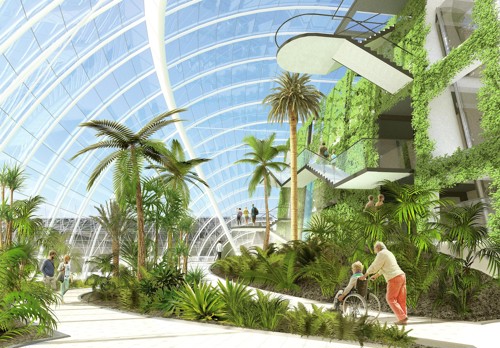
Our History
Founded in 1670 as a physic garden growing medicinal plants, the Royal Botanic Garden Edinburgh has had a remarkable history over the last 350 years.
-
Celebrating 350 years
In 2020 we celebrated the scientific and horticultural achievements of the past 350 years, tracing our progress from 17th century physic garden to world-leading botanic garden.
However, our celebrations were not just about the glories of the past. In our anniversary year, we showed how the current work of the Royal Botanic Garden Edinburgh continues to explore, conserve and explain the world of plants in the face of climate change, and how our ambitious plans help to future-proof the Royal Botanic Garden Edinburgh for the 21st century and beyond.
-
Discover more
- Watch recordings of online events from our 350th anniversary year.
- Read the latest blogs on the history of the Garden
A timeline of our history
- How it all began
-
The Garden was established as a Physic Garden, but medical knowledge of plants had of course already existed for centuries. Published in 1485, the Latin Herbarius (Herbarius in Latino cum figuris) brings together existing texts from medieval, classical and Arabic authors with 150 wood-block illustrations and was intended to provide a guide to medicinal plants for those with no access to a physician. It is the oldest book in our library.
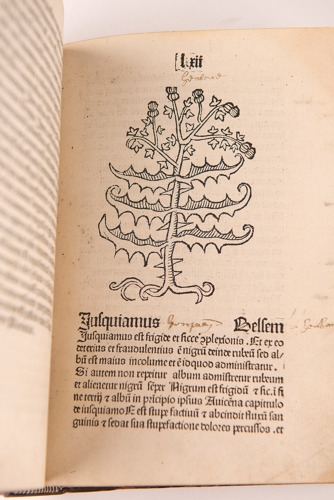
- 1630: Birth of Andrew Balfour, co-founder of the Royal Botanic Garden Edinburgh
-
Together with Robert Sibbald, Dr Andrew Balfour helped to found a Physic Garden at the Palace of Holyroodhouse that would in time develop into the Royal Botanic Garden Edinburgh. The two men were intent on modernising Scotland's approach to medicine and established institutions for the advancement of medicine including the Physic Garden and Royal College of Physicians. After his death, Sibbald memorialised his friend's great achievements in the volume Memoria Balfouriana.
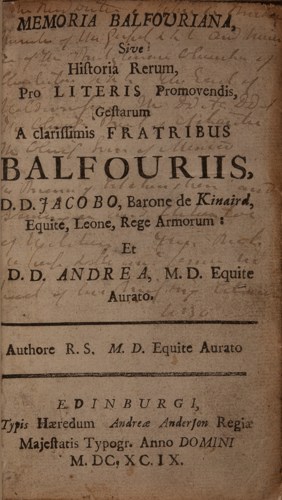
- 1641: Birth of Robert Sibbald, co-founder of the Royal Botanic Garden Edinburgh
-
As well as founding the Physic Garden and the Royal College of Physicians, Robert Sibbald was instrumental in creating the Edinburgh Pharmacopoeia (1685) - the first medical guide in Scotland of recipes and methods for making medicine. The wild flower Sibbaldia procumbens is named after him and he was the first person to describe the blue whale scientifically. It was for a time known as the Sibbaldus or Sibbald's Rorqual.
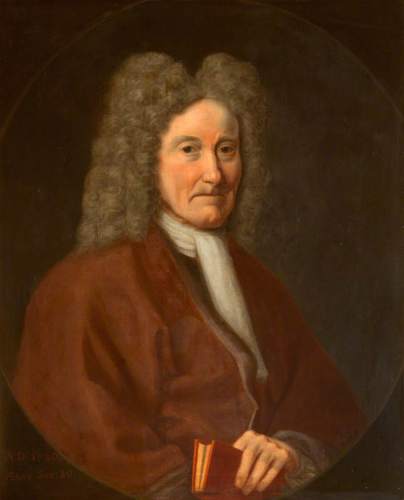
- 1670: Foundation of the RBGE as a physic garden
-
The Physic Garden is established near the Palace of Holyroodhouse by Sir Andrew Balfour and Sir Robert Sibbald, with James Sutherland employed to develop the garden. The purpose of the garden was to supply fresh plants for medical prescriptions and to help teach medical botany to students. It received a royal warrant in 1699 and is the second oldest botanic garden in the United Kingdom.
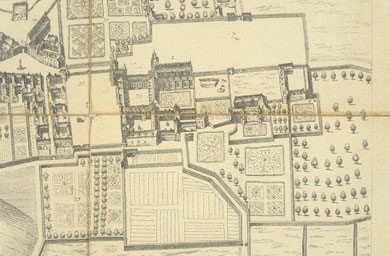
- 1675: The Garden moves to its second site at Trinity Hospital
-
The Garden quickly developed and outgrew its limited plot at Holyrood and permission was given by Edinburgh Town Council to lease the land adjoining Trinity Hospital, enabling the Garden to expand. This new site is now the home of Waverley Station and a plaque marks the spot.

- 1683: Hortus Medicus Edinburgensis: A catalogue of the plants in the Physical Garden at Edinburgh
-
This innovative publication by James Sutherland, first Keeper of the Physic Garden, was the first of its kind in Scotland, and lists the number and rarity of the plants that were now growing in the garden. Sutherland had added to the diversity of plants in the Garden through his own travels in Scotland as well as through the import of plants from across the world. The plants are grown because of their importance to medicine.
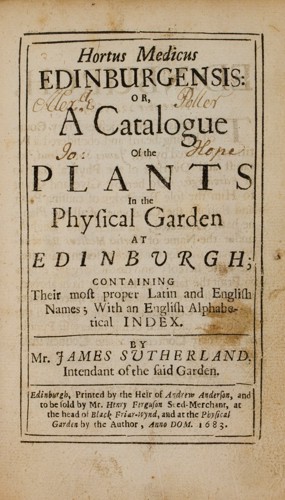
- 1689: The siege of Edinburgh Castle and the flooding of the Garden
-
A siege at the castle had disastrous consequences for the garden when a dam at the east end of the loch was broken and water flooded through the entire site of the Trinity Hospital Garden. “As the flooding subsided, the ground was found to be covered by inches of mud and rubbish from the city drains and all but the hardiest plants, so patiently collected by our founders were practically obliterated”.
- 1699: Granted a Royal Warrant
-
The Garden is granted a Royal Warrant.
- 1697: Cape Myrtle herbarium specimen
-
Collected over 300 years ago, in 1697, this is the oldest preserved specimen found so far in the RBGE Herbarium. It was discovered at the Cape of Good Hope by Alexander Brown, a ship's surgeon who travelled to the Far East from 1692 to 1698. The Cape was a regular stopover point during these long voyages and Brown was one of many botanists who took the opportunity to collect specimens of its rich flora.
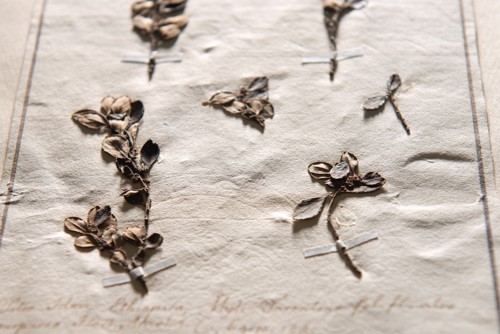
- 1713: The first Glasshouse
-
George Preston, Keeper of the Garden, submitted plans to Edinburgh Town Council for the construction of a greenhouse. It was approved, creating the Garden’s first glasshouse in the summer of 1713. Preston then wrote with pride “... if you have any exotic or rare seeds to send me…I am more capable to preserve them then my predecessors were by reason I have built a Greenhouse and provided all other materials for preserving and cultivating plants…”.
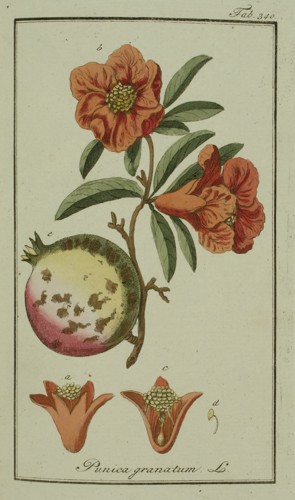
- 1749: Birth of Daniel Rutherford, Regius Keeper from 1786-1819
-
Under Daniel Rutherford’s leadership, a wealth of new tropical and southern hemisphere plants and innovative techniques were introduced to the Garden. As well as overseeing the Garden, he was committed to his own medical practice as, like other early Regius Keepers, Rutherford had trained in medicine. History also remembers him as the uncle of the novelist Sir Walter Scott and as a chemist – he is credited with discovering the gas Nitrogen.
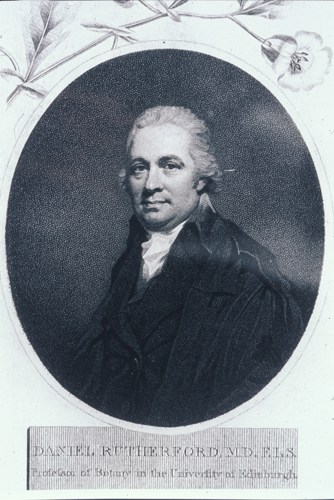
- 1761: Dr John Hope is appointed Regius Keeper
-
One of the most influential of all Regius Keepers, John Hope was a key figure of the Scottish Enlightenment and a supporter of the Swedish botanist Carl Linnaeus’ new system of plant classification. In turn, he inspired his own students such as William Roxburgh, the father of Indian botany, to make major contributions in the botanical world.
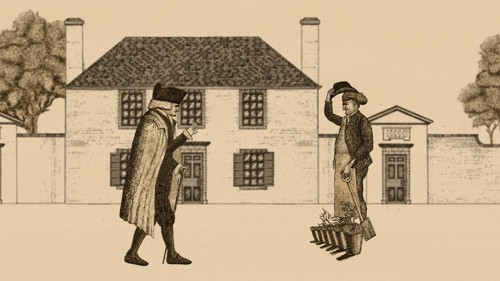
- 1763: The Garden moves to its third site near Leith Walk
-
Under the leadership of Dr John Hope, and with an endowment from the Crown, the Garden moved from the pollution of the Old Town to the cleaner environs of Leith Walk. The new Garden naturally had an area for medicinal plants, but also an aquatic pond, trees and conservatories. In these, Hope was able to grow exotic plants such as bananas, tea and coffee.
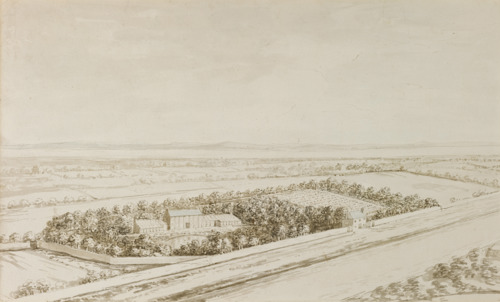
- 1786: Death of John Hope
-
An inspirational leader of the Garden for 25 years, Hope’s success in securing permanent Crown funding helped to support the developing Garden, a precedent that continues to this day. His name is associated with the cultivation of rhubarb, with 3,000 plants grown for medicinal purposes in a plot outside the Leith Walk garden. The genus of plants Hopea, with around 104 species of trees, was named after him.
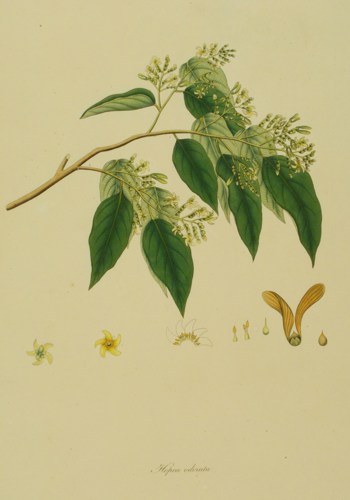
- 1808: Birth of John Hutton Balfour, Regius Keeper from 1845-1880
-
John Hutton Balfour was renowned as an excellent teacher and our archives still hold some of his teaching diagrams, plant models and even one of his microscopes. He was particularly keen on the use of botanical excursions; taking colleagues and students on field trips around Scotland or further afield. Some of Balfour’s excursion diaries still exist, crammed full of train tickets, hotel bills and plant lists – of course.
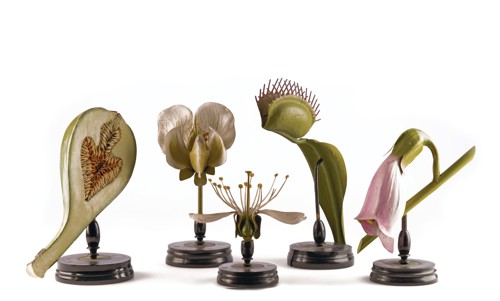
- 1812: James Barry qualifies as a medical doctor from the University of Edinburgh
-
Born a woman, James Barry lived their life as a man, studying medicine at Edinburgh University before a distinguished career as a British Army surgeon. As a medical student, they attended botany lectures at the Leith Walk Garden and later, inspired by the rich flora of South Africa, Barry wrote a paper on Arctopus echinatus and its possible medical uses.
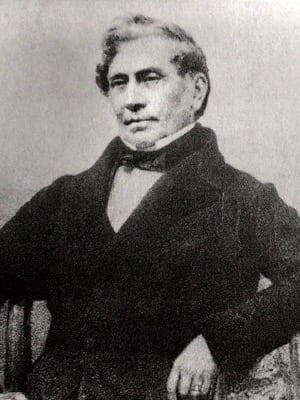
- 1820: The Royal Botanic Garden begins the move to Inverleith
-
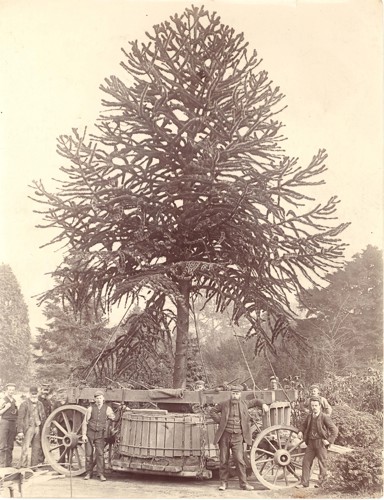
- 1834: Opening of the Tropical Palm House
-
The Tropical Palm House was built at a cost of over £1500 and is a 60 foot wide irregular octagon. The sides are 27 foot high with 18 stone pillars as “Palms required shade”. There are glazed wooden sashes in between each pillar. The conical roof was also made of wood and glass and raised the height to 47 foot - the tallest in Europe until Paxton’s great conservatory was completed at Chatsworth.
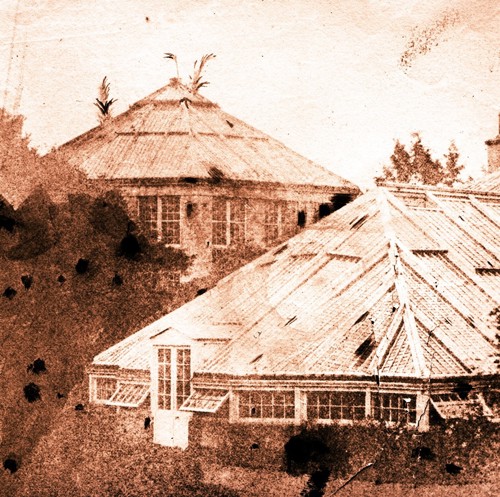
- 1847: The Battle o' Glen Tilt
-
In August 1847, John Hutton Balfour, Regius Keeper, took his students on an excursion from Braemar to Blair Atholl through Glen Tilt. However, they found their way blocked by the Duke of Atholl and a war of words ensued. The impasse ended with the Professor and his students jumping over a wall, but this incident and others eventually paved the way for Scottish Rights of Way. The ‘Battle’ was immortalised in song and paintings.
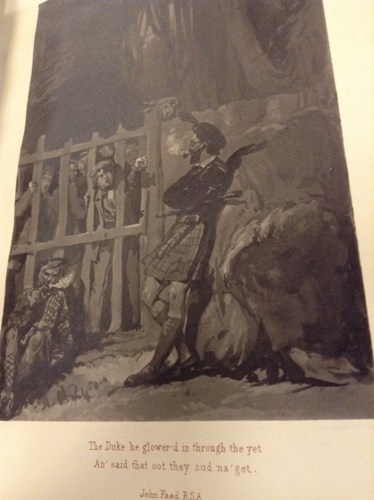
- 1858: Opening of the Temperate Palm House
-
After 20 years, the original Tropical Palm House was considered too small with palms periodically sending their leaves through the roof. In 1855, Parliament agreed to fund £6,000 for a new Palm House and a grand design was created by Robert Matheson. Building commenced in 1856, with pillars, roof and glazing constructed in 1857 and planting completed in spring 1858.
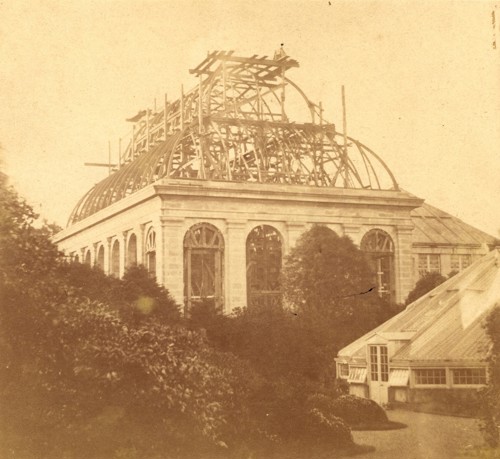
- 1870: The Fossil Tree
-
At 10.5m in length, this Pitys withamii fossil is the largest plant fossil in Scotland and was found at Craigleith Quarry between 1835 and 1865. Originally, it would have formed part of the swamp forests which occurred in this area 320-340 million years ago. While many Edinburgh buildings are also made from Craigleith quarry stone, the Palm Houses are made of stone from Bishopbriggs quarry.
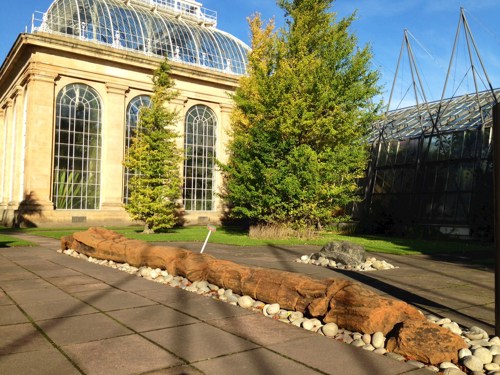
- 1874: The Sabal Bermudana
-
The Sabal bermudana is the oldest plant in our collection. Endemic to the island of Bermuda, it was transported from the Leith Walk garden in 1822 and grew in massive tubs until the beginning of the 20th century when it was transplanted into the ground. We estimate that the Sabal dates from around 1790 and you can still see it today, growing in the centre of our Tropical Palm House.
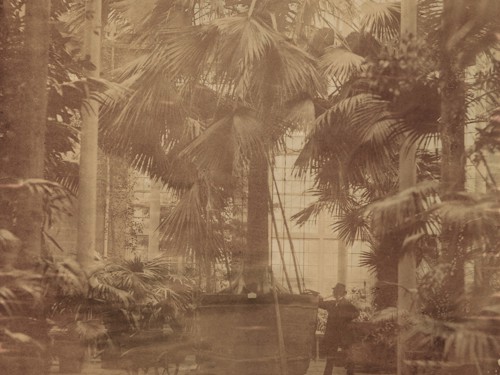
- 1877: Arthur Conan Doyle and Sherlock Holmes
-
Arthur Conan Doyle, creator of Sherlock Holmes, studied medicine at Edinburgh University and botany at the Garden as botany was then a compulsory subject for medical students. In the Holmes novels, Doyle draws on his knowledge of botany and plants as poisons, and has Dr Watson describe Holmes’ knowledge thus: ‘Knowledge of Botany: Variable. Well up in belladonna, opium, and poisons generally. Knows nothing of practical gardening’.
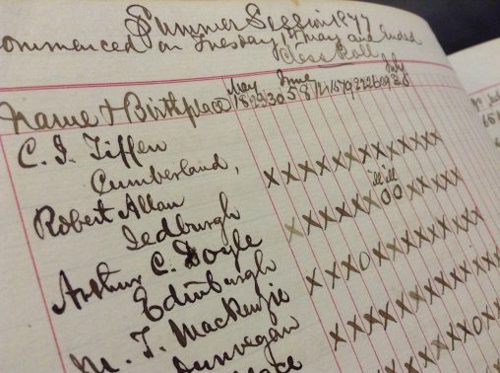
- 1879: "Granny" comes to RBGE
-
“Granny” was the name given to a smooth sea anemone (Actinia equine) which became a visitor attraction at RBGE between 1879 and 1887. Originally caught in 1827 by Sir John Dalyell, ancestor of the late Tam Dalyell MP, she was later given to the Garden’s curators. On her death, Granny was given an obituary in The Scotsman, the first animal to be awarded this honour and a sign of her celebrity!
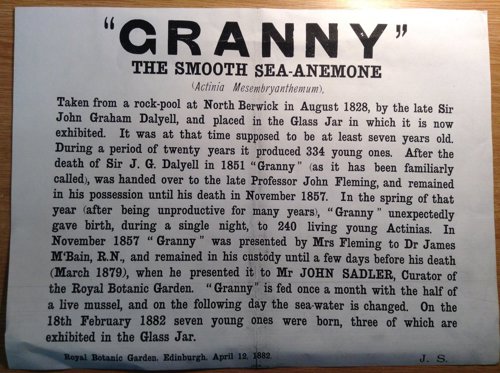
- 1889: The Garden opens on Sundays
-
The Garden starts to open on Sundays, cementing it’s role in the leisure and wellbeing of Edinburgh’s workers.
- 1897: First female gardeners employed
-
The first female gardeners are employed, two of whom went on to establish the Edinburgh School of Gardening for Women.
- 1904: George Forrest, plant collector, arrives in China
-
George Forrest, perhaps the Garden's most iconic collector, was an expert on Chinese plants, travelling there on seven expeditions. He collected species of plants including Primula, Lilium, Meconopsis and Rhododendron, and his legacy is the introduction of hundreds of plants new to science and the establishment of RBGE's internationally renowned rhododendron collection. He died of a heart attack in 1932 and is buried in China.
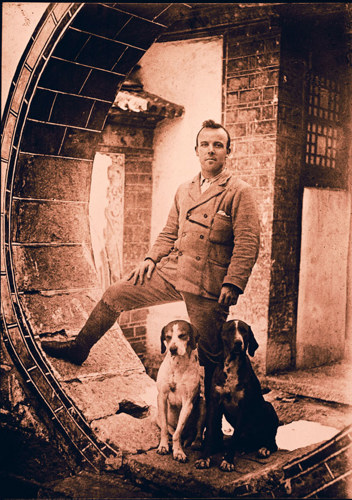
- 1908: The Rock Garden
-
In 1908, reconstruction of the Rock Garden began under the guidance of Regius Keeper, Isaac Bayley Balfour. All was well until 1910 when he decided that a large mound of earth for planting might look better in a slightly different position. The gardeners’ duly moved it, only for him to change his mind the next day and ask them to move it back to its original spot. History doesn’t record their comments!
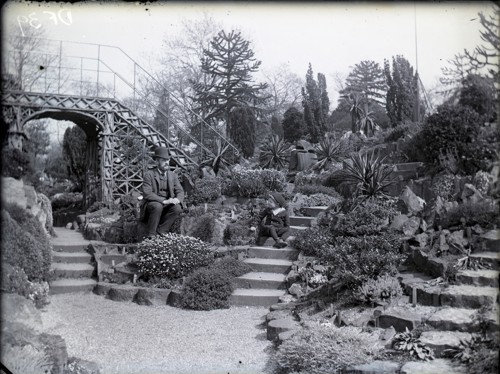
- 1911: The Edinburgh Potato is first described
-
First description of the ‘Edinburgh potato’ – a hybrid recreated at RBGE in 2018.
- 1914-1918: Isaac Bayley Balfour pioneers use of sphagnum moss in World War One
-
Regius Keeper Isaac Bayley Balfour pioneered the use of sphagnum moss to sterilise and dress wounds during World War One.
- 1916: Appointment of Lilian Snelling, botanical artist
-
One of the most highly regarded of the botanical artists represented in the Garden’s art collection is Lilian Snelling (1879-1972). Her work involved capturing microscopic differences between species of plants, with the drawings used as working documents by RBGE scientists. In acknowledgement of her expertise, Snelling was awarded the Victoria Medal of Honour in 1955, the highest horticultural award in Britain.

- 1929: Benmore Botanic Garden becomes our first regional garden
-
Benmore Botanic Garden is renowned for one of the finest entrances to any botanic garden, with its awe-inspiring 157 year old Avenue of giant Redwood trees. Benmore's 120 acres feature Douglas fir, Scots pines and Monkey Puzzle trees, as well as fine collections of rhododendrons, a restored Victorian fernery and a world-famous collection of plants from the Orient and the Himalaya to the Americas.
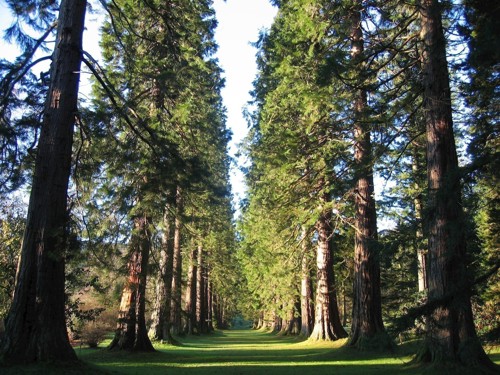
- 1941: Spitfire crashes into the Garden
-
When two Mark 1 Spitfires collided over Edinburgh, one crashed into the garden of RBGE’s then Curator, beside the East Gate. Sadly, the pilot Arthur Wescome Searle died when his parachute failed to open in time, but an excavation of the site in July 2010 discovered poignant artefacts including airframe and engine parts and the stainless-steel cockpit catch that Pilot Officer Searle would have operated just before leaving the aircraft.
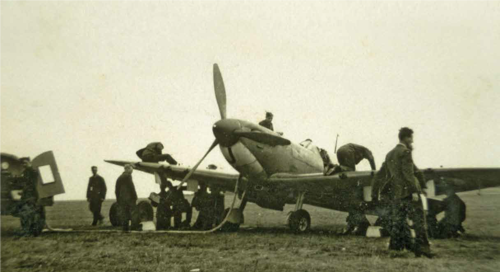
- 1964: Opening of the new Herbarium and Library building
-
The Garden’s Herbarium is a leading botanical collection, used by researchers across the world. It holds three million specimens of plants and covers over 300 years of biodiversity, with the oldest specimen collected in 1697. The Library is Scotland’s national reference collection for specialist botanical and horticultural resources and holds over 1 million items including books, journals, original artworks, maps and much more.
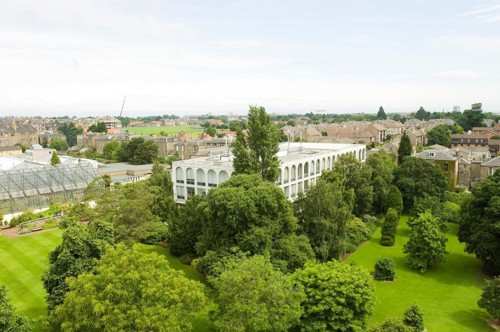
- 1967: Opening of the Front Range glasshouses
-
When Her Royal Highness Princess Margaret opened the new glasshouses, some of the plants were still being stored in containers in the Palm Houses. Unexpectedly, Princess Margaret asked to visit the Palm Houses, so tools and barrows had to be hastily cleared away. Lawrie Buchan, former glasshouse curator recalls throwing them into the pond at the Old Aquatic House and “watched them sink beneath the surface as HRH was shown around”.
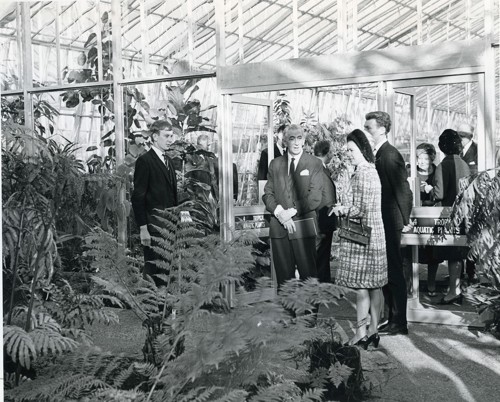
- 1968: Sutherland's yew
-
In the massive storm of 1968, extensive damage was caused to one of our glasshouses and Tropical Palm House skirt. Worse however, was the sad end to our Sutherland’s yew. This ancient tree had grown at Holyrood, was moved to Leith Walk in 1763 and finally to our Inverleith site in 1822. The storm brought the strongest wind gust ever recorded, and blew the yew completely out of the ground.
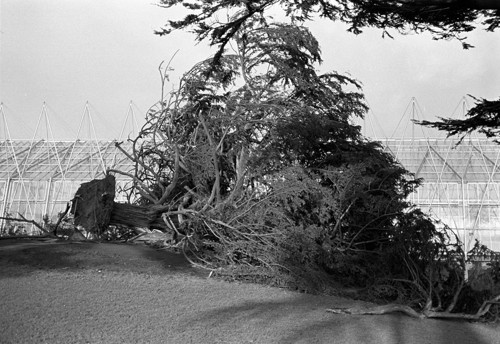
- 1969: Logan Botanic Garden becomes our second regional garden
-
In 2019 the Garden celebrated the 50th anniversary of Logan’s accession to RBGE. Located on the south-western tip of Scotland, Logan enjoys an almost subtropical climate and is known as ‘Scotland’s most exotic Garden’. Warmed by the Gulf Stream which enables plants from Australia, New Zealand, South and Central America and Southern Africa to thrive, the Garden features a spectacular and colourful array of half-hardy perennials.
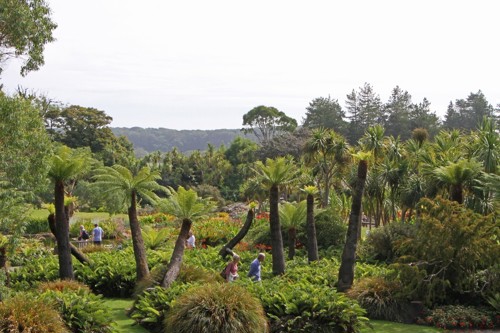
- 1979: Dawyck Botanic Garden becomes our third regional garden
-
Dawyck Botanic Garden, located near Peebles, Scottish Borders, is a five star Garden renowned for its seasonal displays of snowdrops, bluebells, rhododendrons, azaleas, blue poppies and autumn colour. Plants from the mountainous regions of Europe, China, Nepal, Japan and North America thrive here, and many are the first examples collected and brought to Scotland. The Garden is now a sanctuary for endangered plants, as well as a place of beauty.

- 1986: Inverleith House opens as an exhibition space
-
Inverleith House has had many functions. In the 18th century, it served as the family home of Cosmo Innes, the Edinburgh advocate famous for the phrase “The poor hath no lawyers”. In the 19th century it became part of RBGE, while the 20th century has seen it take shape as a gallery of contemporary art, hosting exhibitions by artists such as Andy Warhol and Louise Bourgeois.
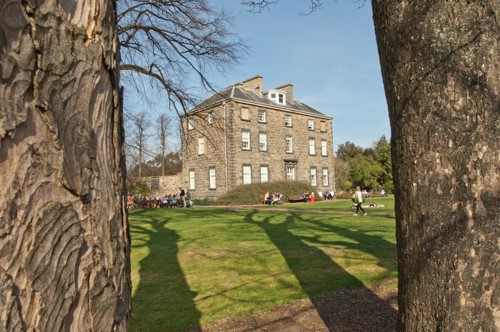
- 1991: Establishment of the Friends of RBGE
-
The Society of the Friends of the Royal Botanic Garden Edinburgh was established with the aim of encouraging interest in the Garden’s work and raising funds for its development. Lady Margaret Elliott became the first Convener, and they attracted 350 Friends in the first two months. Today, the volunteer-led Committees continue to organise an annual programme of events, raising significant funds to support the work of RBGE and its Regional Gardens.
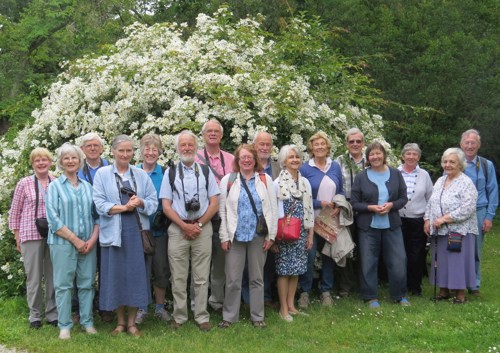
- 1992: MSc in Biodiversity and Taxonomy of Plants founded
-
The MSc in Biodiversity and Taxonomy of Plants was founded, which has to date trained more than 350 students from 49 countries.
- 2001: Partnership with Lijiang Botanic Garden, China
-
Our scientists and horticulturists have been working in China since the early 20th century and the Edinburgh Garden has the largest Living Collection of Chinese plants in cultivation outside China. As a leading centre of expertise in plant science, we continue to work closely with the Chinese government and partners including Lijiang Botanic Garden to help understand and conserve China’s globally important flora of around 30,000 species.
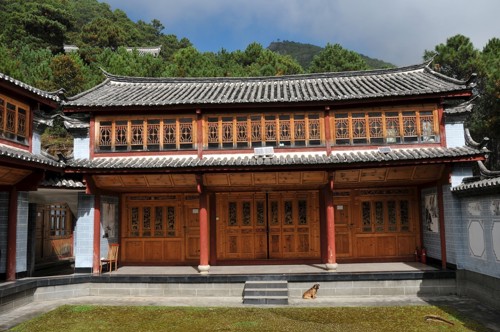
- 2002: Flora of Bhutan completed
-
The nine volumes of the Flora of Bhutan were completed, a project running since 1975.
- 2003: The journal Sibbaldia launches
-
Sibbaldia, the first peer-reviewed international journal of botanic garden horticulture, was launched.
- 2006: Opening of the Queen Mother's Memorial Garden
-
The Queen Mother’s garden was designed to reflect her life with a structure inspired by her childhood at Glamis Castle. The Bog Myrtle creating the labyrinth is a native of the Scottish Highlands and other flora reflect her travels to Asia, Europe, North America and the Southern Hemisphere. The fine Pavilion reflects Scotland with native oak seating, shells from across Scotland and pine cones from our four Gardens.
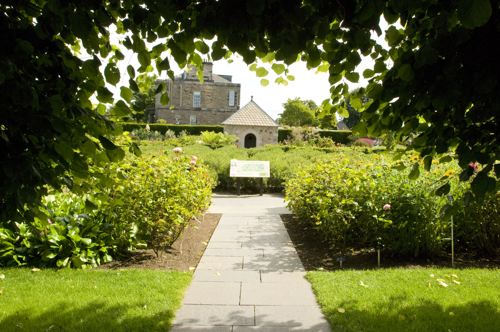
- 2010: Opening of the John Hope Gateway
-
Named after one of the Garden's most visionary leaders, the John Hope gateway entrance on the west side of the Garden was opened by Her Majesty the Queen, accompanied by HRH the Duke of Edinburgh. The Gateway building was designed to include new spaces for exhibitions, education, dining, retail and events, enabling the public to learn more about the work of the Garden in a beautiful airy space.
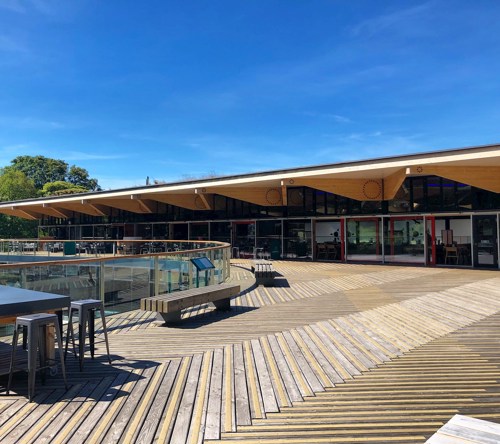
- 2012: Storm damage
-
Considerable damage was caused when 100mph winds swept across the Front Range and support glasshouses. While over 500 panes of glass were lost in the 1960s houses, the Victorian Palm Houses were hardly affected at all. Sadly, more than 40 trees were blown over, including some that were hundreds of years old and others that were important in the history and development of the Garden’s Living Collection.
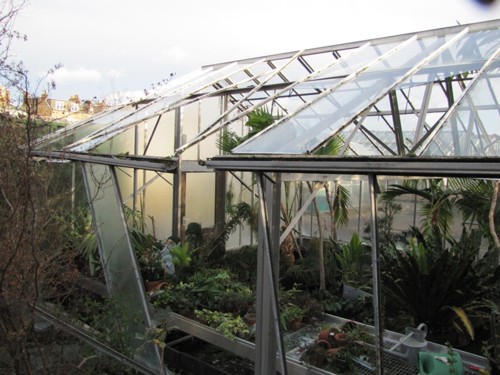
- 2015: Digitisation of the Herbarium collection
-
The Herbarium collection is one of the most active in the world, receiving up to 30,000 specimens each year. In 2015, an ongoing project to digitise the entire collection reached its 10% landmark as the 300,000th specimen was digitised. There are over three million specimens in the Herbarium, covering over 300 years of biodiversity and representing half to two thirds of the world’s flora.
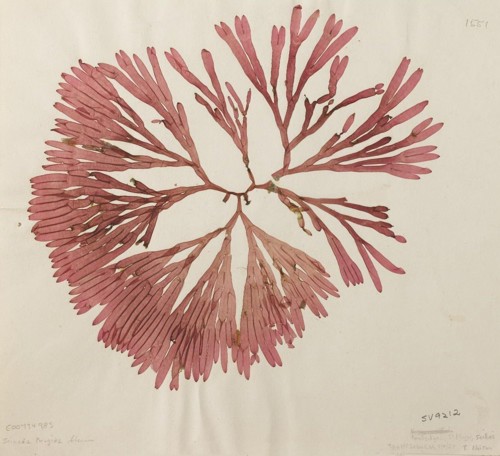
- 2016: Reopening of the Botanic Cottage
-
The Garden’s Botanic Cottage originally served as the principal gardener’s home, botany classroom for medical students and main entrance to the Leith Walk garden. Left behind on Leith Walk, the cottage fell into disrepair and was narrowly saved from demolition by a community campaign in 2008. Moved stone-by-stone to its new site at Inverleith, once again it is a hub for learning, used regularly by education and community groups.
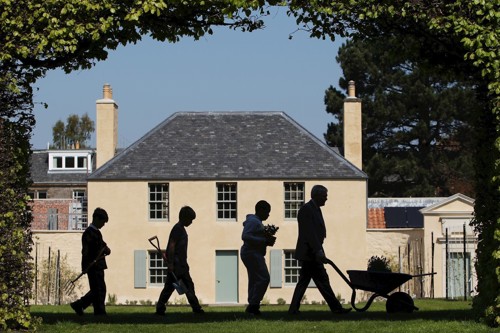
- 2019: Flowering of the Amorphophallus titanum or 'corpse flower'
-
The Amorphophallus titanum in our Tropical Glasshouse is a rare and endangered specimen from Western Sumatra. The plant arrived at the Garden in 2003 and expert nurturing has enabled it to flower three times since 2015. The flower emits a foul stench while in full bloom to attract pollinating insects, and each flowering allows our botanists to further develop their knowledge of this remarkable plant, aiding long-term conservation efforts.
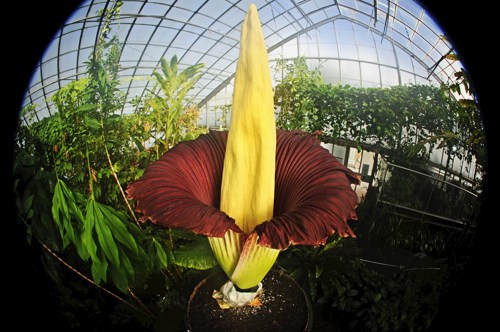
- 2019: Edinburgh Biomes
-
The Garden embarks on one of its most ambitious projects - the Edinburgh Biomes - to help secure the future of the Garden as a leader in plant science and horticulture, and continue the battle to conserve the world's plants.
